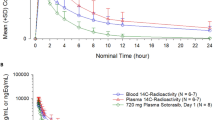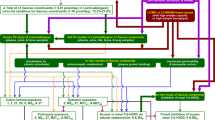Abstract
Background and Objectives
The oral bioavailability of withangulatin A (WA) is low and may undergo first-pass metabolism because of the presence of two esters bonds. This study aimed to identify the hydrolysis behavior and mechanism of WA, thus enriching its structure-pharmacokinetic relationship.
Methods
The in vivo pharmacokinetic studies of WA in rats were first investigated, followed by in vitro assays including metabolic stability, phenotyping identification and metabolic kinetics assays. After screening out the responsible enzymes with higher catalytic capacity, molecular docking study was performed to demonstrate the interaction mode between WA and metabolic enzymes. Then, metabolites in human serum albumin (HSA) were identified by LC-TOF-MS/MS.
Results
In rats, the oral bioavailability of WA was only 2.83%. In vitro, WA was hydrolyzed in both rat and human plasma and could not be inhibited by selective esterase inhibitors. Physiologic concentration of HSA not recombinant human carboxylesterases (rhCES) could significantly hydrolyze WA, and it had a similar hydrolytic capacity with human plasma to WA. Furthermore, WA could stably bind to HSA by forming hydrogen bonds with Lys199 and Arg410, accompanied by the metabolic reaction of the lactone ring opening.
Conclusion
The study showed that WA underwent obvious hydrolysis in rat and human plasma, which implied a strong first-pass effect. Serum albumin rather than common esterases primarily contributed to the hydrolytic metabolism of WA in plasma.










Similar content being viewed by others
Availability of Data and Materials
Not applicable.
Code Availability
Not applicable.
References
Chen CM, Chen ZT, Hsieh CH, Li WS, Wen SY. Withangulatin A, a new withanolide from Physalis angulata. Heterocycles. 1990;31(7):1371–5.
Zhan X, Liao X, Luo X, Zhu Y, Feng S, Yu C, et al. Comparative metabolomic and proteomic analyses reveal the regulation mechanism underlying MeJA-induced bioactive compound accumulation in cutleaf groundcherry (Physalis angulata L.) hairy roots. J Agric Food Chem. 2018;66(25):6336–47.
Ma T, Zhang WN, Yang L, Zhang C, Lin R, Shan SM, et al. Cytotoxic withanolides from Physalis angulata var. villosa and the apoptosis-inducing effect via ROS generation and the activation of MAPK in human osteosarcoma cells. RSC Adv. 2016;6(58):53089–100.
Sun L, Liu J, Cui D, Li J, Yu Y, Ma L, et al. Anti-inflammatory function of withangulatin A by targeted inhibiting COX-2 expression via MAPK and NF-kappaB pathways. J Cell Biochem. 2010;109(3):532–41.
Zhu T, Chen C, Wang S, Zhang Y, Zhu D, Li L, et al. Cellular target identification of withangulatin A using fluorescent analogues and subsequent chemical proteomics. Chem Commun. 2019;55(57):8231–4.
Chen C, Gong L, Liu X, Zhu T, Zhou W, Kong L, et al. Identification of peroxiredoxin 6 as a direct target of withangulatin A by quantitative chemical proteomics in non-small cell lung cancer. Redox Biol. 2021;46: 102130.
Chen C, Zhu T, Liu X, Zhu D, Zhang Y, Wu S, et al. Identification of a novel PHGDH covalent inhibitor by chemical proteomics and phenotypic profiling. Acta Pharm Sin B. 2021. https://doi.org/10.1016/j.apsb.2021.06.008.
Lu Y, Bao N, Borjihan G, Ma Y, Hu M, Yu C, et al. Contribution of carboxylesterase in hamster to the intestinal first-pass loss and low bioavailability of ethyl piperate, an effective lipid-lowering drug candidate. Drug Metab Dispos. 2011;39(5):796–802.
Qiu Z, Li N, Song L, Lu Y, Jing J, Parekha HS, et al. Contributions of intestine and plasma to the presystemic bioconversion of vicagrel, an acetate of clopidogrel. Pharm Res. 2014;31(1):238–51.
Tsujikawa K, Kuwayama K, Miyaguchi H, Kanamori T, Iwata YT, Inoue H. In vitro stability and metabolism of salvinorin A in rat plasma. Xenobiotica. 2009;39(5):391–8.
Li B, Sedlacek M, Manoharan I, Boopathy R, Duysen EG, Masson P, et al. Butyrylcholinesterase, paraoxonase, and albumin esterase, but not carboxylesterase, are present in human plasma. Biochem Pharmacol. 2005;70(11):1673–84.
Bahar FG, Ohura K, Ogihara T, Imai T. Species difference of esterase expression and hydrolase activity in plasma. J Pharm Sci. 2012;101(10):3979–88.
Ge GB, Ai CZ, Hu WB, Hou J, Zhu LL, He GY, et al. The role of serum albumin in the metabolism of Boc5: molecular identification, species differences and contribution to plasma metabolism. Eur J Pharm Sci. 2013;48(1–2):360–9.
Smith SA, Waters NJ. Pharmacokinetic and pharmacodynamic considerations for drugs binding to alpha-1-acid glycoprotein. Pharm Res. 2018;36(2):30.
Rabbani G, Ahn SN. Structure, enzymatic activities, glycation and therapeutic potential of human serum albumin: A natural cargo. Int J Biol Macromol. 2019;123:979–90.
Kono K, Fukuchi Y, Okawa H, Nunoya KI, Imawaka H, Watanabe H, et al. Unique hydrolysis of an ester-type prodrug of levodopa in human plasma: relay-type role sharing between alpha-1 acid glycoprotein and human serum albumin. Mol Pharm. 2019;16(10):4131–8.
Zhuang Y, Sun Q, Jing T, et al. Contributions of intestine and liver to the absorption and disposition of FZJ-003, a selective JAK1 inhibitor with structure modification of filgotinib. Eur J Pharm Sci. 2022;175:106211. https://doi.org/10.1016/j.ejps.2022.106211.
Tibbitts J. Issues related to the use of canines in toxicologic pathology–issues with pharmacokinetics and metabolism. Toxicol Pathol. 2003;31(Suppl):17–24.
Ratnatilaka Na Bhuket P, Niwattisaiwong N, Limpikirati P, Khemawoot P, Towiwat P, Ongpipattanakul B, et al. Simultaneous determination of curcumin diethyl disuccinate and its active metabolite curcumin in rat plasma by LC-MS/MS: application of esterase inhibitors in the stabilization of an ester-containing prodrug. J Chromatogr B Analyt Technol Biomed Life Sci. 2016. https://doi.org/10.1016/j.jchromb.2016.08.039.
Tai T, Zhou H, Zhu T, Jia YM, Ji JZ, Li YF, et al. Development and validation of a UPLC-MS/MS method for simultaneous determination of vicagrel and its major metabolites in rat or human plasma: an optimized novel strategy for the stabilization of vicagrel. J Pharm Biomed Anal. 2020;179: 112955.
Goncharov NV, Belinskaia DA, Shmurak VI, Terpilowski MA, Jenkins RO, Avdonin PV. Serum albumin binding and esterase activity: mechanistic interactions with organophosphates. Molecules. 2017;22(7):1201.
Lei W, Wang DD, Dou TY, Hou J, Feng L, Yin H, et al. Assessment of the inhibitory effects of pyrethroids against human carboxylesterases. Toxicol Appl Pharmacol. 2017;321:48–56.
Czub MP, Boulton AM, Rastelli EJ, Tasker NR, Maskrey TS, Blanco IK, et al. Structure of the complex of an iminopyridinedione protein tyrosine phosphatase 4A3 phosphatase inhibitor with human serum albumin. Mol Pharmacol. 2020;98(6):648–57.
Watanabe H, Tanase S, Nakajou K, Maruyama T, Kragh-Hansen U, Otagiri M. Role of arg-410 and tyr-411 in human serum albumin for ligand binding and esterase-like activity. Biochem J. 2000;349:813–9.
Di L. The Impact of carboxylesterases in drug metabolism and pharmacokinetics. Curr Drug Metab. 2019;20(2):91–102.
Ascenzi P, Leboffe L, di Masi A, Trezza V, Fanali G, Gioia M, et al. Ligand binding to the FA3-FA4 cleft inhibits the esterase-like activity of human serum albumin. PLoS ONE. 2015;10(3): e0120603.
Qiu ZX, Gao WC, Dai Y, Zhou SF, Zhao J, Lu Y, et al. Species comparison of pre-systemic bioactivation of vicagrel, a new acetate derivative of clopidogrel. Front Pharmacol. 2016;7:366.
De Simone G, di Masi A, Ascenzi P. Serum albumin: a multifaced enzyme. Int J Mol Sci. 2021;22(18):10086.
Liederer BM, Borchardt RT. Enzymes involved in the bioconversion of ester-based prodrugs. J Pharm Sci. 2006;95(6):1177–95.
Kumar D, Bhattacharyya R, Banerjee D. Pseudosterase activity-based specific detection of human serum albumin on gel. Talanta. 2021;224: 121906.
Zhang H, Samadi AK, Cohen MS, Timmermann BN. Anti-proliferative withanolides from the Solanaceae: a structure-activity study. Pure Appl Chem. 2012;84(6):1353–67.
Xu YM, Brooks AD, Wijeratne EM, Henrich CJ, Tewary P, Sayers TJ, et al. 17beta-Hydroxywithanolides as sensitizers of renal carcinoma cells to tumor necrosis factor-alpha related apoptosis inducing ligand (TRAIL) mediated apoptosis: Structure-activity relationships. J Med Chem. 2017;60(7):3039–51.
Acknowledgements
We thank Jia Liu from Pharmaceutical Animal Experimental Center of China Pharmaceutical University for guiding the animal experiments. We also express our appreciation to Xi Xu for his help in molecular docking study.
Funding
This work was supported by the National Natural Science Foundation of China (No. 81872746).
Author information
Authors and Affiliations
Contributions
Experimental design: YZ, ZQ. Animal experiment: YZ, YW. LC-MS/MS analysis: YZ, NL, HM. Manuscript writing and revision: YZ, YW, ZL, JL, ZQ.
Corresponding authors
Ethics declarations
Conflict of Interest
There are no conflicts of interest declared by all the authors.
Ethical Approval
The experiment was performed in accordance with the Internal Charter on the Humane Care and Use of Laboratory Animal and supported by Ethics Committee of China Pharmaceutical University (approval number: 2022-04-012).
Consent to Participate
Not applicable.
Consent for publication
Not applicable.
Supplementary Information
Below is the link to the electronic supplementary material.
Rights and permissions
Springer Nature or its licensor (e.g. a society or other partner) holds exclusive rights to this article under a publishing agreement with the author(s) or other rightsholder(s); author self-archiving of the accepted manuscript version of this article is solely governed by the terms of such publishing agreement and applicable law.
About this article
Cite this article
Zhuang, Y., Wang, Y., Li, N. et al. Hydrolytic Metabolism of Withangulatin A Mediated by Serum Albumin Instead of Common Esterases in Plasma. Eur J Drug Metab Pharmacokinet 48, 363–376 (2023). https://doi.org/10.1007/s13318-023-00834-8
Accepted:
Published:
Issue Date:
DOI: https://doi.org/10.1007/s13318-023-00834-8




